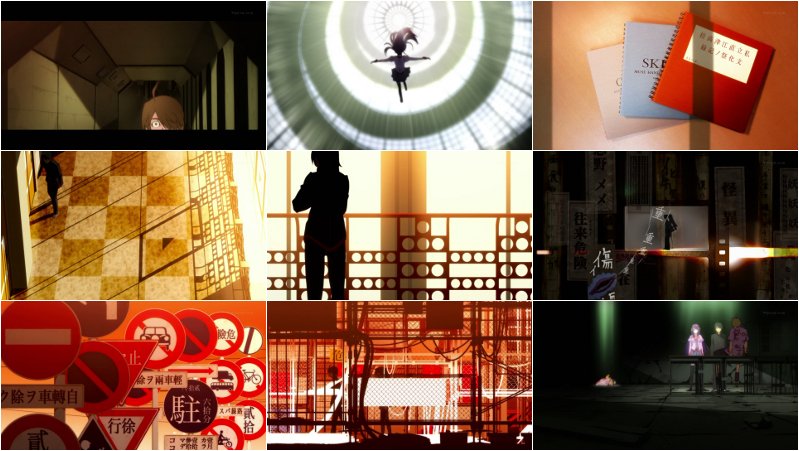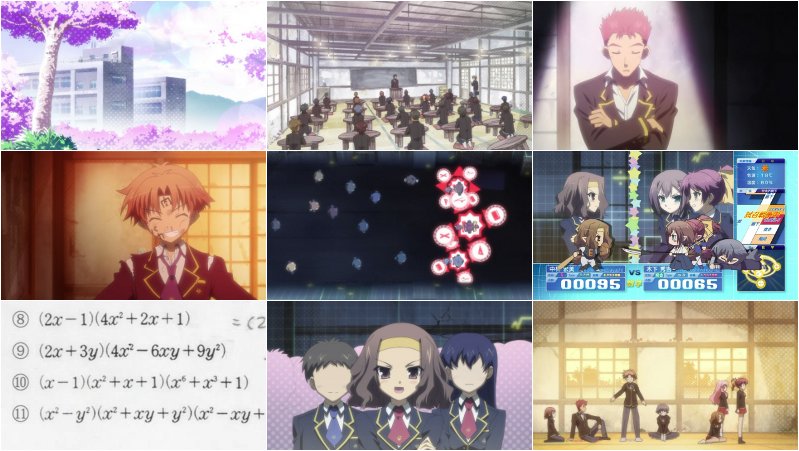As I may have mentioned, I have a recurring problem with SHAFT productions and the work of their director Akiyuki Shinbo. That problem is that while I like the art direction & design in their shows, the actual material they are adapting leaves me cold. Mainly it’s the fact they tend to handle otaku pandering material that’ll shift DVD units and merchandise in Japan.
This week they launched the latest of Shinbo’s works, an adaptation of the manga Dance In The Vampire Bund. Also launched this week was Baka to Test to Shoukanjuu from frequent SHAFT collaborator SILVER LINK, with Shin Oonuma directing. Oonuma worked on many SHAFT shows like Ef, Natsu no Arashi & Pani Poni Dash. In fact looking at the staff list it’s only animation director Miwa Oshima who seems the odd one out, with much the remaining staff coming with Oonuma from Ef. So I’ll be looking at that show as well, as it’s an interesting comparison to Dance In The Vampire Bund. And finally, to get some perspective, I’ll take a look at the first episode of last years Bakemonogatari, the show that cemented Shinbo as an otaku favourite.
Bakemonogatari Episode 1

With a completely different story, or possibly just a different script I’d probably love this. But when you’ve got characters in a show about ghost stories discussing and using otaku jargon, it feels like they are grasping for those otaku wallets a little too hard.
Visually of course, it’s fantastic. While Shinbo’s particular fetishes are all over the show – namely typography, geometrical design and near subliminal editing – he allows Akio Watanabe to bring plenty of himself to the show too in the action and character design. The only real flaw in Shinbo’s approach for me is his love of dialogue, too many long conversations and monologues slow the show down, even with all the visual tricks he pulls to try and keep them interesting. While that could be said to be the fault of the script, the fact is he does it across a lot of his shows, so it’s clearly something he digs himself. To the point where you think rather than a way around bad scripts, Shinbo thinks Wally Wood’s 22 Panels That Always Work are the be-all and end-all to visual storytelling.
While it’s not for me, though the ghost story aspect comes really close in making me want more, I can definitely see why so many people really loved it. It’s not just a lazy otaku pandering show, though there’s plenty of that if you are a lazy otaku obsessed with specific character traits and slang, but it has a distinct visual style that will appeal to the aesthetes too.
Dance in the Vampire Bund Episode 1

This time round Shinbo is working with Naoyuki Konno (009-1, Cyborg 009, Kikaider) as animation director and character design, and again, the animation director’s own individuality shines through. Though it’s worth noting that it’s Masahiro Sonoda credited as series director, with Shinbo just listed as director.
Once more the show suffers from its source material. Not only does it feel like someone’s Vampire The Masquerade campaign, but the lead is one of those HONEST GUV THEY’RE OVER EIGHTEEN characters that crop in both anime and vampire fiction far too often. And so was absolutely guaranteed to show up in the new vampire anime from the makers of Moonphase. As clever as the actual set up of this first episode is, it’s not enough to get me to follow the adventures of an underage vampire princess and her lycanthropic bodyguard.
What is clever about this episode, is it takes the artifice of the Shaft/Shinbo aesthetic and finds a way to make it work in a realistic fashion. The entire episode takes place on a variety panel show where celebrities are debating the existence, or not, of vampires. This gives them an opportunity to actually work their fetishes for typography and monologues into the story in a way that feels natural, rather than cutting to subliminal interstitials or unnatural camera angles. Here that’s all part of the fictional TV show within the show.
Watching it again in light of watching Bakemonogatari though, as clever as the device of the TV show is, it doesn’t do as a good a job of hiding the weaknesses of the story. Though they’ve really got their work cut out on hiding the weaknesses in Nozomu Tamaki’s trashy manga, so I can cut them some slack. Won’t be coming back for more though.
Baka to Test to Shoukanjuu Episode 1

And what we have here is SHAFT-lite. Or shite for short.
If it wasn’t for so many SHAFT alumni on the staff, it’d be really easy to accuse this of blatant me-too-ing of their formula of abstract design. Oh what the hell, it’s a blatant attempt at recreating the formula that’s served SHAFT well on a lower budget and with less able hands.
Most egregiously you can see it in the ending credits which hamfistedly tries to do what Shinbo does with typography to the English translation of the songs lyrics. And fails miserably. But that’s just the topper on a show that clumsily tries for a minimalist “manga on the screen” approach along the likes of Sayonara ZetsubÅ Sensei. Unlike that show, they haven’t got a decent manga to crib for the design notes, and so they just end up sticking ziptone everywhere willy nilly.
Which is a shame, as the actual concept for the series is fine, even though it feels like a failed pitch for a DS game that someone turned into a light novel. Classes at a bizarre school fight one another in exam battles, involving the summoning of super-deformed versions of themselves. Combined with the visuals of the battles, in particularly the overhead views of characters like pieces in a tactical board game, it leaves you with the impression that someone really wants this made into a videogame at some point.
However videogame aesthetics do not a good cartoon make, particularly when the game doesn’t even exist yet.